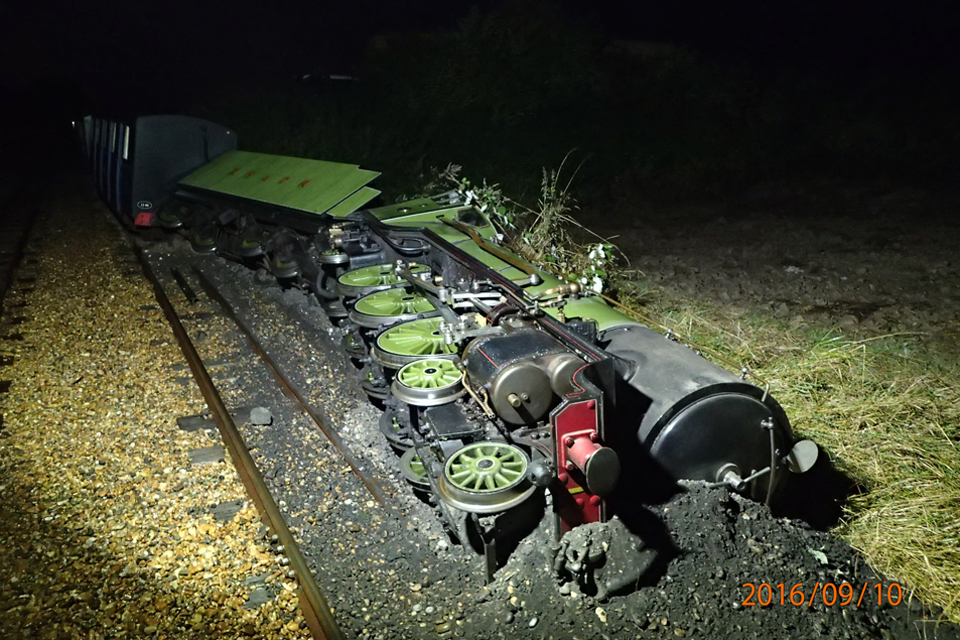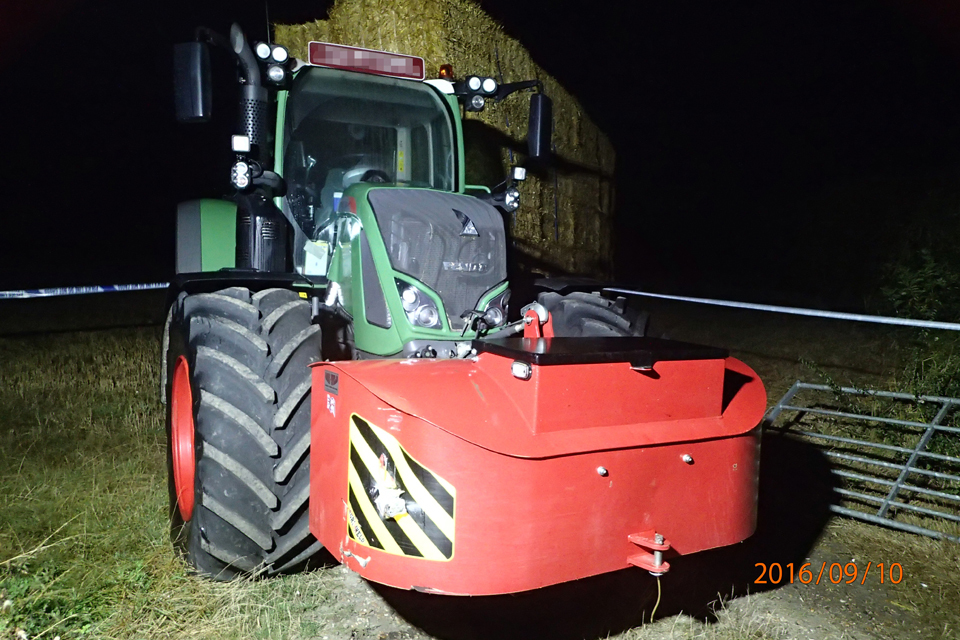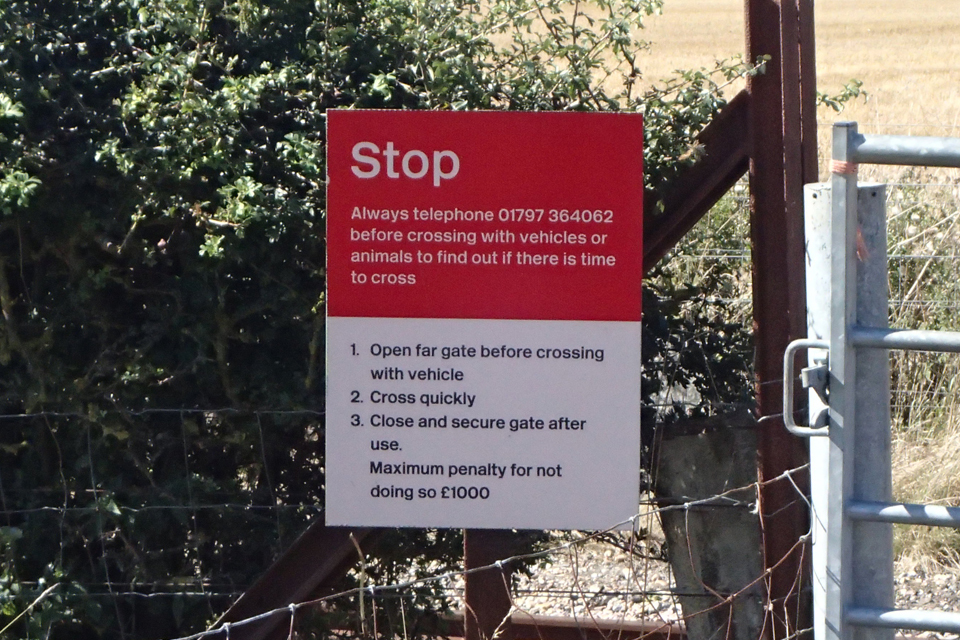Level crossing collision, near Dymchurch, 10 September 2016
Published 29 November 2016
1. Important safety messages
In this instance, the tractor driver did not use the level crossing in accordance with the instructions provided on the signs. However there remain important safety messages for the railways. Infrastructure owners and operators should pay particular attention to the importance of:
- briefing authorised users of user worked level crossings (UWC) about the correct method of use and the importance of them passing this information on to their employees and subcontractors
- considering the need for suitable risk mitigation when a crossing is in heavy use, for example during the harvest season
- implementing effective and practical risk mitigation when it is observed that level crossing gates have been left open.
2. Summary of the accident
On Saturday 10 September at around 14:30 hrs, a Romney Hythe and Dymchurch Railway (RH&DR) train, comprising a 381 mm (15 inch) gauge miniature steam engine coupled to 13 coaches and carrying between 50 and 80 people, struck a tractor at a user worked level crossing. The gated crossing, RH&DR railway occupation crossing number 10, known as ‘Young’s Crossing’, lies on a farm track between a field, where harvesting and straw baling had been taking place, and the nearest public road.

A night time view light by floodlights showing Romney Hythe and Dymchurch locomotive Number 1 'Green Goddess' lying on its left hand side after the accident. The locomotive is partly buried in the black ballast which has piled up around it.
The tractor driver had used the crossing several times earlier in the day and the gates were open when, shortly before the accident, he drove his tractor over the level crossing to collect a trailer loaded with straw and parked a short distance from the railway. After hitching up the trailer he moved the tractor towards the crossing and, seeing the train in the distance, stopped to wait for it to pass.
The train driver saw the tractor in the distance initially stationary, then moving towards the railway and then stationary again. As the train got closer, its driver became aware that the tractor was close to the railway and sounded the train’s whistle. On hearing the whistle the tractor driver realised that he was probably too close to the line and began to engage reverse gear. About 50 metres from the crossing the train driver realised that the train would collide with the tractor and applied full braking to his train. Due to the time taken for the brakes to take full effect and the initial speed of the train, it was still travelling at an estimated 15 mph (24 km/h) when the front of the locomotive struck the front counter-weight on the tractor, which was overhanging the line. The tractor driver stated that he managed to engage reverse gear and was just starting to move when the train hit the counter-weight.

A night time view of the large green tractor involved in the accident. The train hit the red counter-weight attached to the front of the tractor.
The impact caused the steam engine and its tender to derail and tip onto their left-hand sides, coming to rest approximately 23 metres beyond the crossing. The first coach of the train was also derailed but remained upright. The front of the tractor was pushed sideways into the crossing gate and post.
The train driver jumped clear of his engine shortly after the initial impact and was not injured. There were no serious injuries. The emergency services attended and the passengers were conveyed by road to their destinations.
3. Causes of the accident
The tractor driver did not use the crossing in accordance with the instructions on the sign. He was not very familiar with this level crossing, having only used it for one day prior to the day of the accident. The tractor driver neither opened and closed the gates each time he crossed, nor telephoned the railway before using the crossing. Neither this driver nor any other farm worker had contacted the railway for permission to cross while harvesting was in progress during the week leading up to the accident.

One of the red and white signs displayed on either side of the crossing. This tells crossing users to stop and phone the signaller if they need to move animals or vehicles across the crossing and explains what actions they need to take..
The RH&DR had not briefed the authorised user of this UWC in recent years and had no record of doing so earlier. The method described on the sign had not been briefed to the tractor driver by either his employer (a contractor working for the farm occupier), or by the farm occupier.
Having entered the crossing through the open gate and seen the train, the tractor driver incorrectly judged his stopping position, such that the tractor was partly blocking the line. He was not able to move his tractor away from the line quickly enough to avoid a collision once he realised his mistake.
The railway’s rules require that its drivers should ‘keep a good look out on the approach to [user worked] crossings and be prepared to stop short of any obstruction’. The train driver did not realise that the front of the tractor was partly blocking the line until it was too late to stop the train before hitting the tractor.
Some railway staff were aware that the crossing was being used for harvesting operations during the previous week, and the railway controller had warned train drivers earlier in the day that the crossing gates had been left open. The RH&DR had not taken any other action to deal with the open gates or the increased risk of crossing misuse when the crossing was especially busy due to harvesting work.
4. Previous similar occurrences
A collision at Black Horse Drove UWC, Cambridgeshire, in which a tractor was struck by a train, resulted in the death of the tractor driver and minor injuries to people on the train. The authorised user of the crossing had not received a briefing on the correct use of the crossing from Network Rail and the farm manager did not realise that any specific briefing on its use was necessary. The resulting RAIB investigation (RAIB report 12/2006) recommended that all infrastructure owners should write to all authorised users of user worked crossings, regardless of type, to draw their attention to the correct method for using each crossing.
A train struck a 44 tonne articulated tanker and derailed at Sewage Works Lane UWC, Suffolk, causing serious injuries to several passengers and train crew. The authorised user had not briefed the tanker driver’s employer on the safe operation of the crossing. The resulting RAIB investigation (RAIB report 14/2011) recommended that Network Rail remind the authorised users of their responsibilities to brief their staff and contractors on the safe use of user worked crossings. Although this recommendation was aimed at Network Rail, it is pertinent to all infrastructure owners with UWCs.
At Buttington Hall UWC, Powys, a train struck a tractor during the harvest period. A crossing attendant was in place but the system of work was unsafe, leading to ineffective control of road movements over the crossing. The resulting RAIB investigation (RAIB report 06/2014) recommended that infrastructure owners define safe and practical working methods to be adopted when UWCs are being used intensively and that these methods should be communicated through authorised users to all staff using the UWC.
You can print this safety digest.

